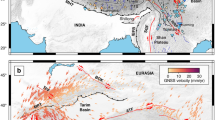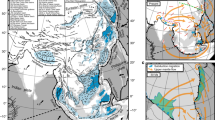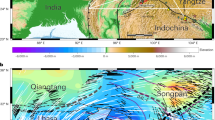Abstract
The Tibetan Plateau is undergoing eastward extension on north-trending rifts, but the cause is unclear. The extension is commonly thought to represent gravitational collapse and outward spreading of the plateau1,2,3,4,5, a view based on observations of the synchronous onset of regional extension during the middle to late Miocene4,6,7,8,9,10,11,12,13. However, rifting in southern Tibet occurs at a faster rate and is more developed than in the north, implying that rifting could instead be caused by progressive underthrusting of the Indian Plate beneath the southern plateau14,15,16,17. Here we use three-dimensional numerical models, constrained by structural and thermochronological data sets, to simulate extension of the Lunggar rift in southern Tibet as the orogenic system evolves. Our simulations reveal slow extension beginning in the Miocene, synchronously throughout the rift, followed by a wave of rapid extension that sweeps northwards along the rift, slightly ahead of the underthrusting Indian slab. Although the initial period of slow extension is consistent with orogen-scale gravitational collapse, we suggest that the subsequent extension at a high rate and magnitude in southern Tibet reflects thinning of the upper crust in response to thickening of the lower crust as the Indian plate is underthrust. Our results demonstrate that large-magnitude upper-crustal extension can occur during peak orogenic events, as well as during post-orogenic collapse.
This is a preview of subscription content, access via your institution
Access options
Subscribe to this journal
Receive 12 print issues and online access
$259.00 per year
only $21.58 per issue
Buy this article
- Purchase on Springer Link
- Instant access to full article PDF
Prices may be subject to local taxes which are calculated during checkout



Similar content being viewed by others
Change history
20 January 2015
In the version of this Letter originally published, the first sentence of the main text was incorrect, and should have read 'The elevation of an orogenic plateau or mountain belt is limited in part by the tectonic compressive stresses at the orogen's margins that support the high elevations and consequent high gravitational potential energy1,5,18'. In the last sentence of the Methods section refs 20,21 were cited instead of refs 11,12. These errors have been corrected in all versions of the Letter.
References
Dewey, J. F. Extensional collapse of orogens. Tectonics 7, 1123–1139 (1988).
Dewey, J. F., Shackleton, R. M., Chengfa, C. & Yiyin, S. The tectonic evolution of the Tibetan Plateau. Phil. Trans. R. Soc. Lond. A 327, 379–413 (1988).
Molnar, P., England, P. & Martinod, J. Mantle dynamics, uplift of the Tibetan Plateau, and the Indian monsoon. Rev. Geophys. 31, 357–396 (1993).
Harrison, T. M., Copeland, P., Kidd, W. S. F. & Yin, A. Raising Tibet. Science 255, 1663–1670 (1992).
England, P. & Houseman, G. Extension during continental convergence, with application to the Tibetan Plateau. J. Geophys. Res. 94, 17561–17579 (1989).
Lee, J. et al. Middle to late Miocene extremely rapid exhumation and thermal reequilibration in the Kung Co rift, southern Tibet. Tectonics 30, TC2002 (2011).
Kapp, J. L. A. et al. Nyainqentanglha Shan: A window into the tectonic, thermal, and geochemical evolution of the Lhasa block, southern Tibet. J. Geophys. Res B. 110, B08413 (2005).
Blisniuk, P. M. et al. Normal faulting in central Tibet since at least 13.5 Myr ago. Nature 412, 628–632 (2001).
Kapp, P., Taylor, M., Stockli, D. & Ding, L. Development of active low-angle normal fault systems during orogenic collapse: Insight from Tibet. Geology 36, 7–10 (2008).
Ratschbacher, L. et al. Rifting and strike-slip shear in central Tibet and the geometry, age and kinematics of upper crustal extension in Tibet. Geol. Soc. Lond. Spec. Pub. 353, 127–163 (2011).
Styron, R. H. et al. Miocene initiation and acceleration of extension in the South Lunggar rift, western Tibet: Evolution of an active detachment system from structural mapping and (U–Th)/He thermochronology. Tectonics 32, 880–907 (2013).
Sundell, K. E. et al. Evidence for constriction and Pliocene acceleration of east–west extension in the North Lunggar rift region of west central Tibet. Tectonics 32, 1454–1479 (2013).
Woodruff, W. H., Horton, B. K., Kapp, P. & Stockli, D. F. Late Cenozoic evolution of the Lunggar extensional basin, Tibet: Implications for basin growth and exhumation in hinterland plateaus. GSA Bull. 125, 343–358 (2013).
DeCelles, P. G., Robinson, D. M. & Zandt, G. Implications of shortening in the Himalayan fold-thrust belt for uplift of the Tibetan Plateau. Tectonics 21, 1062–1086 (2002).
Copley, A., Avouac, J. P. & Wernicke, B. P. Evidence for mechanical coupling and strong Indian lower crust beneath southern Tibet. Nature 472, 79–81 (2011).
Liu, M. & Yang, Y. Extensional collapse of the Tibetan Plateau: Results of three-dimensional finite element modeling. J. Geophys. Res. B. 108, B002248 (2003).
Kapp, P. & Guynn, J. Indian punch rifts Tibet. Geology 32, 993–996 (2004).
Rey, P., Vanderhaeghe, O. & Teyssier, C. Gravitational collapse of the continental crust: Definition, regimes and modes. Tectonophysics 342, 435–449 (2001).
Vissers, R. L. M., Platt, J. P. & Van der Wal, D. Late orogenic extension of the Betic Cordillera and the Alboran Domain: A lithospheric view. Tectonics 14, 786–803 (1995).
Yin, A. Cenozoic tectonic evolution of Asia: A preliminary synthesis. Tectonophysics 488, 293–325 (2010).
Molnar, P. & Stock, J. M. Slowing of India’s convergence with Eurasia since 20 Ma and its implications for Tibetan mantle dynamics. Tectonics 28, TC3001 (2009).
Zhang, P. Z. et al. Continuous deformation of the Tibetan Plateau from global positioning system data. Geology 32, 809–812 (2004).
Lavé, J. & Avouac, J. P. Active folding of fluvial terraces across the Siwaliks Hills, Himalayas of central Nepal. J. Geophys. Res. B 105, 5735–5770 (2000).
Ader, T. et al. Convergence rate across the Nepal Himalaya and interseismic coupling on the Main Himalayan Thrust: Implications for seismic hazard. J. Geophys. Res. B 117, B04403 (2012).
Nábělek, J. et al. Underplating in the Himalaya–Tibet collision zone revealed by the Hi-CLIMB experiment. Science 325, 1371–1374 (2009).
Yin, A. et al. Significant late Neogene east–west extension in northern Tibet. Geology 27, 787–790 (1999).
Liu, C-Z., Wu, F-Y., Chung, S-L. & Zhao, Z-D. Fragments of hot and metasomatized mantle lithosphere in Middle Miocene ultrapotassic lavas, southern Tibet. Geology 39, 923–926 (2011).
Block, L. & Royden, L. H. Core complex geometries and regional scale flow in the lower crust. Tectonics 9, 557–567 (1990).
Clark, M. K. & Royden, L. H. Topographic ooze: Building the eastern margin of Tibet by lower crustal flow. Geology 28, 703–706 (2000).
Braun, J. et al. Quantifying rates of landscape evolution and tectonic processes by thermochronology and numerical modeling of crustal heat transport using PECUBE. Tectonophysics 524, 1–28 (2012).
Acknowledgements
We thank P. Kapp, A. McCallister, B. Horton, W. Woodruff and D. Liu for collaboration in the field, and D. Stockli and R. Kislitsyn for laboratory collaboration and assistance. We thank P. DeCelles and J-P. Avouac for reviews. This work was supported in part by the Tectonics Division of the National Science Foundation. We thank T. Becker for feedback on a previous version of the manuscript.
Author information
Authors and Affiliations
Contributions
R.S. performed the thermal modelling. R.S. and K.S. created the data sets. All authors participated in field mapping, sample collection, conceptual model development and manuscript preparation.
Corresponding authors
Ethics declarations
Competing interests
The authors declare no competing financial interests.
Supplementary information
Supplementary Information
Supplementary Information (PDF 623 kb)
Rights and permissions
About this article
Cite this article
Styron, R., Taylor, M. & Sundell, K. Accelerated extension of Tibet linked to the northward underthrusting of Indian crust. Nature Geosci 8, 131–134 (2015). https://doi.org/10.1038/ngeo2336
Received:
Accepted:
Published:
Issue Date:
DOI: https://doi.org/10.1038/ngeo2336
This article is cited by
-
Southern Tibetan rifting since late Miocene enabled by basal shear of the underthrusting Indian lithosphere
Nature Communications (2023)
-
Fault systems impede incision of the Yarlung river into the Tibetan plateau
Communications Earth & Environment (2023)
-
Mississippi Valley-type Zn–Pb deposits in orogenic thrust belts: ore formation in response to synorogenic crustal transpression or extension
Mineralium Deposita (2023)
-
Timing and mechanisms of Tibetan Plateau uplift
Nature Reviews Earth & Environment (2022)
-
Geochemistry and tectonic setting of Middle Ordovician MORB-like basalts in the Kunlun Orogen: implications for a back-arc environment
Arabian Journal of Geosciences (2021)



